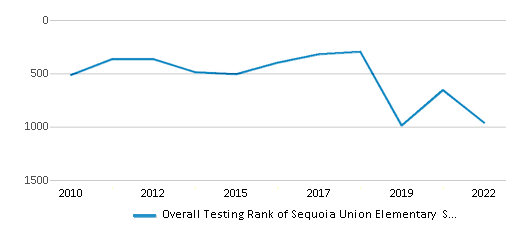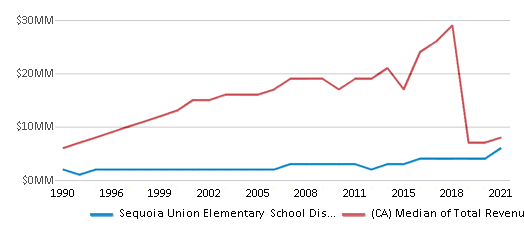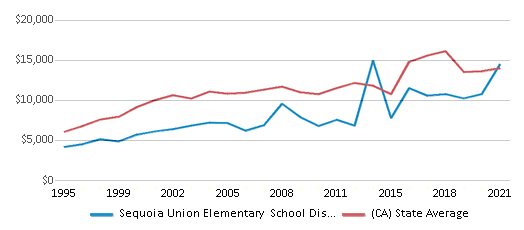Top Rankings
Sequoia Union Elementary School District ranks among the top 20% of public school district in California for:
Category
Attribute
Student Attention
Lowest student:teacher ratio (Top 1%)
For the 2025 school year, there is 1 public charter school serving 348 students in Sequoia Union Elementary School District. This district's average charter testing ranking is 6/10, which is in the top 50% of public charter schools in California.
Public Charter School in Sequoia Union Elementary School District have an average math proficiency score of 32% (versus the California public charter school average of 31%), and reading proficiency score of 37% (versus the 48% statewide average).
Minority enrollment is 42% of the student body (majority Hispanic), which is less than the California public charter school average of 75% (majority Hispanic).
Overview
This School District
This State (CA)
# Schools
2 Schools
1,300 Schools
# Students
384 Students
711,386 Students
# Teachers
26 Teachers
31,394 Teachers
Student : Teacher Ratio
15:1
15:1
District Rank
Sequoia Union Elementary School District, which is ranked #966 of all 1,925 school districts in California (based off of combined math and reading proficiency testing data) for the 2021-2022 school year.
Overall District Rank
#964 out of 1941 school districts
(Top 50%)
(Top 50%)

Math Test Scores (% Proficient)
30%
33%

Reading/Language Arts Test Scores (% Proficient)
39%
47%

Science Test Scores (% Proficient)
40-44%
29%
Students by Ethnicity:
Diversity Score
0.54
0.65
# American Indian Students
n/a
3,137 Students
% American Indian Students
n/a
1%
# Asian Students
6 Students
49,250 Students
% Asian Students
2%
7%
# Hispanic Students
142 Students
378,755 Students
% Hispanic Students
37%
53%
# Black Students
n/a
48,500 Students
% Black Students
n/a
7%
# White Students
220 Students
176,738 Students
% White Students
57%
25%
# Hawaiian Students
n/a
2,385 Students
% Hawaiian Students
n/a
n/a
# Two or more races Students
16 Students
48,230 Students
% of Two or more races Students
4%
7%
Students by Grade:
# Students in PK Grade:
-
83
# Students in K Grade:
55
60,517
# Students in 1st Grade:
44
46,070
# Students in 2nd Grade:
32
47,155
# Students in 3rd Grade:
43
46,520
# Students in 4th Grade:
44
46,583
# Students in 5th Grade:
40
46,919
# Students in 6th Grade:
43
54,274
# Students in 7th Grade:
47
57,837
# Students in 8th Grade:
36
57,970
# Students in 9th Grade:
-
70,272
# Students in 10th Grade:
-
64,790
# Students in 11th Grade:
-
57,670
# Students in 12th Grade:
-
54,726
# Ungraded Students:
-
-
District Revenue and Spending
The revenue/student of $14,615 in this school district is less than the state median of $19,974. The school district revenue/student has declined by 11% over four school years.
The school district's spending/student of $12,823 is less than the state median of $18,396. The school district spending/student has declined by 11% over four school years.
Total Revenue
$6 MM
$116,387 MM

Spending
$5 MM
$107,188 MM

Revenue / Student
$14,615
$19,974

Spending / Student
$12,823
$18,396

Best Sequoia Union Elementary School District Public Charter Schools (2025)
School
(Math and Reading Proficiency)
(Math and Reading Proficiency)
Location
Grades
Students
Rank: #11.
Sequoia Elementary Charter
Charter School
(Math: 30-34% | Reading: 35-39%)
Rank:
Rank:
6/
Top 50%10
23958 Avenue 324
Lemon Cove, CA 93244
(559) 564-2106
Lemon Cove, CA 93244
(559) 564-2106
Grades: K-7
| 348 students
Recent Articles

Year-Round Or Traditional Schedule?
Which is more appropriate for your child? A year-round attendance schedule or traditional schedule? We look at the pros and cons.

Why You Should Encourage Your Child to Join a Sports Team
Participating in team sports has a great many benefits for children, there is no doubt. In this article you will learn what those benefits are.

White Students are Now the Minority in U.S. Public Schools
Increasing birth rates among immigrant families from Asia and Central and South America, combined with lower birth rates among white families, means that for the first time in history, public school students in the United States are majority-minority. This shift in demographics poses difficulties for schools as they work to accommodate children of varying language abilities and socio-economic backgrounds.





